Firstly, in the fast digital world that everybody knows about; consumers want everything quick, simple, and easy as there is no complexity anymore. While e-com has the luxury of viewing it, bricks-and-mortar merchants have to get imaginative to provide the clients an incentive to desire for a physical journey and consume tangible and additionally help them by doing life uncomplicated.Self-Service Kiosks in Retail One of such passive kiosk solution that has come and made a big shake in retail, InmoQR is changing the tradition al retail outlet and transforming it into a kiosk for better customer satisfaction and experience.
Data up to October 2023 Rise of the Self-Service Kiosks in Retail
But in a matter of months, self-service kiosks began popping up in retail — grocery, apparel, electronics, home improvement, you name it. Here, the customers do all the hovering over product details, order placement and payment from the point of the touch screens.
The growing need for the self-service kiosks market is also a result of technological developments, shifting customer behaviors, and businesses striving to optimize their operations. New research shows the global self-service kiosk market will continue to grow at a steady pace, driven by the need for contactless solutions and increased customization, all quite rightly so.
How Self-Service Kiosks in Retail Play into the Customer Experience
Speed and Convenience
Main Functions of Self-Service Kiosks for Customer Service in QSRs As a world that is gritting its teeth with demanding instant gratification, long lines suck the patience from even the most resilient of customers. Unlike traditional checkout lanes, self-service kiosks help consumers bypass the hassle of waiting in line, locating their desired products, and even purchasing them too.
Not only does it deliver customers faster, but it also provides that much-needed capacity for retailers to process more in less time — a key
Tailoring and Personalization Kiosks in Retail
The self-service kiosks provide the customers the comfort of a customized shopping experience. These machines will be interactive meaning you can program them to suggest based on others buying history or customer history. For instance, fashion stores can have the kiosks suggesting an outfit depending on the latest trends or based on the individual shopper’s style choices.
And as if that was not enough, customers now had the option of customizing their orders especially at food & beverage outlets where customers had the opportunity to customize their orders as per their own tastes. Such depth of personalization builds intimacy between the consumer and the brand and paves the way for loyalty and repeat visits.
Information and Promotion from the seller of the Product
The modern consumer is savvy and does more research into a product than you might think before buying it. Self-service kiosks–with specifications of the products, backups availability, prices and customer reviews–are a significant step towards giving customers the information they want. This transparency empowers customers to make informed decisions, boosting their confidence in their purchases.
Kiosks also showcase offers such as promotions, discounts, and loyalty rewards offers, prompting customers to try new products or avail a limited time offer.
Increased Order Accuracy
If you work with complicated orders — think restaurants or specialized retailers — implementing a self-service kiosk can minimize errors by a lot. By allowing customers to fill out the orders themselves, there is less room for miscommunication between your customer and staff. Correct orders also enhance customer experience; while at the same time they reduce wastage of food or product returns, saving expenses for the organization.
Enhanced Staff Productivity
Self-service kiosks are not a replacement for retail staff and merely complement the roles of retail staff. If kiosks are dealing with everyday activities like ordering, looking for products, and payments, staff has more time to spend on other, more value-adding activities — like helping customers with specific requests, upselling products, or managing and replenishing inventory. This redefinition of roles allows for improved store operations and a more interactive experience for the customers who walk through the door.
Self-Service Kiosk Implementation Challenges And Considerations
Indeed, the advantages are evident, but the deployment of self-service kiosks is not free of issues. Businesses have to be extra careful with aspects of UI designing, accessibility, data security, and system maintenance. Frustrated customers can be the result of a poorly designed kiosk, meanwhile lapses in security can threaten customer trust.
To achieve a successful deployment, businesses must work with reputable kiosk providers that care about ease of use, offer strong support and have an understanding of the retail environment.
Self-Service Kiosks in Retail: The Journey Ahead
Answer: Self-service kiosks at retail stores are just the tip of the iceberg. With further evolution of artificial intelligence and machine learning, prospects of APIs of kiosks providing intelligent and predictive services rise. AI-enabled kiosks, for example, might instantly assess customer data to provide dynamic pricing or to recommend add-on purchases.
Additionally, the emergence of contactless and cashless payments in a post-pandemic environment makes kiosks a safer choice to traditional checkouts as well as being more hygienic. The focus on hygiene and social distancing will obviously lead to even more widespread adoption of self-service kiosks in different retail segments.
Conclusion
In short, self-service kiosks are transforming the physical shopping experience of the customers by providing them with a faster, more convenient, customized and better experience with accuracy. It creates a sense of ownership for customers as they feel like they own the shopping experience, and for retailers, it helps them streamline their operations and allocate resource in a far better manner. This technology is a fantastic move for physical retailers to protect a competitive advantage and evolve into greater success within a continuously digitalising retail landscape.
As self-service kiosks become more sophisticated over the years, retailers that jump on a trend can expect big ROI down the way through a fully integrated shopping experience that brings customers back repeatedly.
